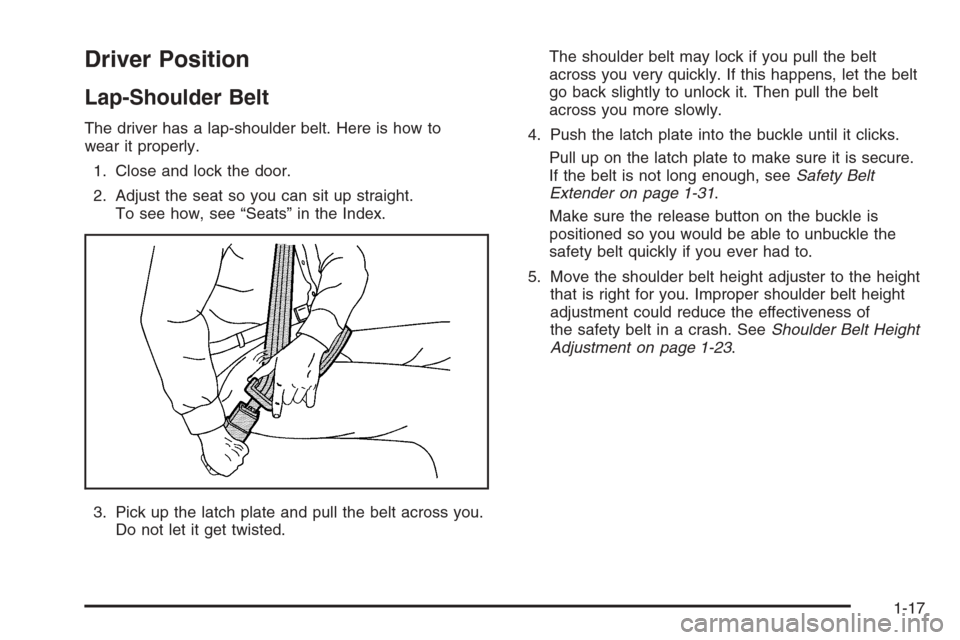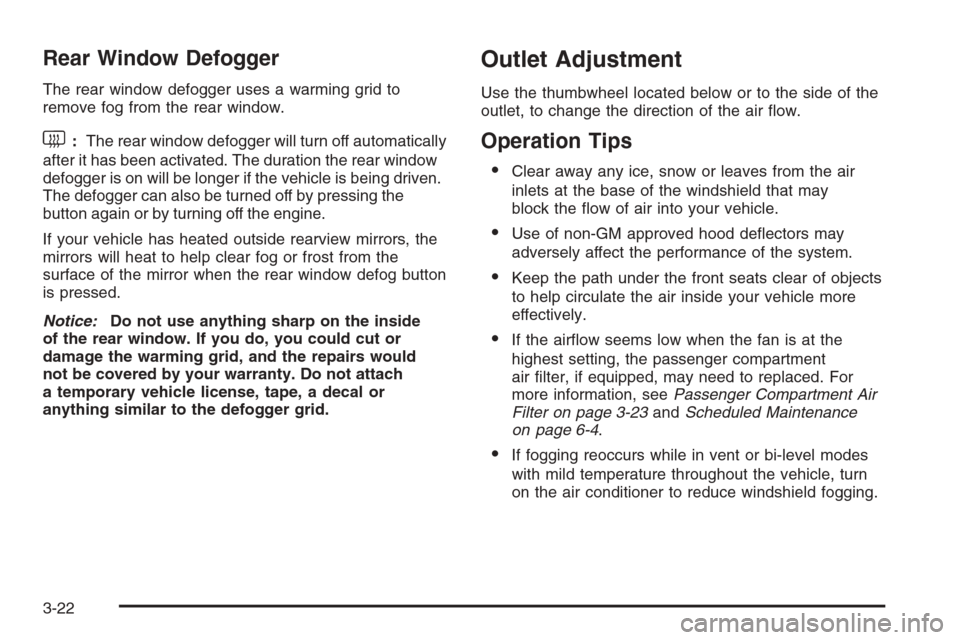2006 CHEVROLET IMPALA seat adjustment
[x] Cancel search: seat adjustmentPage 7 of 394

Front Seats......................................................1-2
Manual Passenger Seat..................................1-2
Six-Way Power Seats.....................................1-2
Eight-Way Power Seats...................................1-3
Manual Lumbar..............................................1-4
Heated Seats.................................................1-4
Reclining Seatbacks........................................1-5
Head Restraints.............................................1-8
Center Seat...................................................1-9
Rear Seats.......................................................1-9
Split Folding Rear Seat...................................1-9
Safety Belts...................................................1-12
Safety Belts: They Are for Everyone................1-12
Questions and Answers About Safety Belts......1-16
How to Wear Safety Belts Properly.................1-16
Driver Position..............................................1-17
Shoulder Belt Height Adjustment.....................1-23
Safety Belt Use During Pregnancy..................1-24
Right Front Passenger Position.......................1-24
Center Front Passenger Position.....................1-25
Rear Seat Passengers..................................1-26
Rear Safety Belt Comfort Guides....................1-29
Safety Belt Pretensioners...............................1-31
Safety Belt Extender.....................................1-31
Child Restraints.............................................1-32
Older Children..............................................1-32Infants and Young Children............................1-34
Child Restraint Systems.................................1-38
Where to Put the Restraint.............................1-42
Lower Anchors and Tethers for Children
(LATCH)..................................................1-43
Securing a Child Restraint in a Rear
Seat Position............................................1-49
Securing a Child Restraint in the Center
Front Seat Position....................................1-51
Securing a Child Restraint in the Right Front
Seat Position............................................1-52
Airbag System...............................................1-55
Where Are the Airbags?................................1-57
When Should an Airbag In�ate?.....................1-60
What Makes an Airbag In�ate?.......................1-61
How Does an Airbag Restrain?.......................1-61
What Will You See After an
Airbag In�ates?.........................................1-62
Passenger Sensing System............................1-63
Servicing Your Airbag-Equipped Vehicle...........1-67
Adding Equipment to Your Airbag-Equipped
Vehicle....................................................1-68
Restraint System Check..................................1-69
Checking the Restraint Systems......................1-69
Replacing Restraint System Parts
After a Crash............................................1-70
Section 1 Seats and Restraint Systems
1-1
Page 23 of 394

Driver Position
Lap-Shoulder Belt
The driver has a lap-shoulder belt. Here is how to
wear it properly.
1. Close and lock the door.
2. Adjust the seat so you can sit up straight.
To see how, see “Seats” in the Index.
3. Pick up the latch plate and pull the belt across you.
Do not let it get twisted.The shoulder belt may lock if you pull the belt
across you very quickly. If this happens, let the belt
go back slightly to unlock it. Then pull the belt
across you more slowly.
4. Push the latch plate into the buckle until it clicks.
Pull up on the latch plate to make sure it is secure.
If the belt is not long enough, seeSafety Belt
Extender on page 1-31.
Make sure the release button on the buckle is
positioned so you would be able to unbuckle the
safety belt quickly if you ever had to.
5. Move the shoulder belt height adjuster to the height
that is right for you. Improper shoulder belt height
adjustment could reduce the effectiveness of
the safety belt in a crash. SeeShoulder Belt Height
Adjustment on page 1-23.
1-17
Page 142 of 394

Rear Window Defogger
The rear window defogger uses a warming grid to
remove fog from the rear window.
<:The rear window defogger will turn off automatically
after it has been activated. The duration the rear window
defogger is on will be longer if the vehicle is being driven.
The defogger can also be turned off by pressing the
button again or by turning off the engine.
If your vehicle has heated outside rearview mirrors, the
mirrors will heat to help clear fog or frost from the
surface of the mirror when the rear window defog button
is pressed.
Notice:Do not use anything sharp on the inside
of the rear window. If you do, you could cut or
damage the warming grid, and the repairs would
not be covered by your warranty. Do not attach
a temporary vehicle license, tape, a decal or
anything similar to the defogger grid.
Outlet Adjustment
Use the thumbwheel located below or to the side of the
outlet, to change the direction of the air �ow.
Operation Tips
Clear away any ice, snow or leaves from the air
inlets at the base of the windshield that may
block the �ow of air into your vehicle.
Use of non-GM approved hood de�ectors may
adversely affect the performance of the system.
Keep the path under the front seats clear of objects
to help circulate the air inside your vehicle more
effectively.
If the air�ow seems low when the fan is at the
highest setting, the passenger compartment
air �lter, if equipped, may need to replaced. For
more information, seePassenger Compartment Air
Filter on page 3-23andScheduled Maintenance
on page 6-4.
If fogging reoccurs while in vent or bi-level modes
with mild temperature throughout the vehicle, turn
on the air conditioner to reduce windshield fogging.
3-22
Page 383 of 394

Charging System Light....................................3-30
Check
Engine Light...............................................3-34
Checking Things Under the Hood......................5-10
Chemical Paint Spotting...................................5-90
Child Restraints
Child Restraint Systems...............................1-38
Infants and Young Children...........................1-34
Lower Anchors and Tethers for Children..........1-43
Older Children.............................................1-32
Securing a Child Restraint in a Rear Seat
Position..................................................1-49
Securing a Child Restraint in the Center
Front Seat Position...................................1-51
Securing a Child Restraint in the Right
Front Seat Position...................................1-52
Where to Put the Restraint...........................1-42
Cigarette Lighter.............................................3-18
Cleaning
Aluminum Wheels........................................5-89
Exterior Lamps/Lenses.................................5-87
Fabric/Carpet..............................................5-85
Finish Care.................................................5-88
Inside of Your Vehicle..................................5-84
Instrument Panel, Vinyl, and Other Plastic
Surfaces.................................................5-86Cleaning (cont.)
Leather......................................................5-86
Tires..........................................................5-89
Underbody Maintenance...............................5-90
Washing Your Vehicle...................................5-87
Weatherstrips..............................................5-87
Windshield and Wiper Blades........................5-88
Climate Control System...................................3-19
Air Filter, Passenger Compartment.................3-23
Outlet Adjustment........................................3-22
Collision Damage Repair..................................7-10
Comfort Guides, Rear Safety Belt.....................1-29
Compact Spare Tire........................................5-83
Compass.......................................................3-44
Content Theft-Deterrent....................................2-17
Control of a Vehicle.......................................... 4-6
Convenience Net............................................2-43
Coolant
Engine Temperature Gage............................3-33
Engine Temperature Warning Light.................3-32
Heater, Engine............................................2-24
Cooling System..............................................5-31
Courtesy Lamps.............................................3-15
Cruise Control................................................3-10
Cruise Control Light........................................3-38
Cupholder(s)..................................................2-42
3
Page 389 of 394

O
Odometer......................................................3-26
Off-Road Recovery..........................................4-13
Oil
Engine.......................................................5-17
Pressure Light.............................................3-36
Oil, Engine Oil Life System..............................5-20
Older Children, Restraints................................1-32
Online Owner Center........................................ 7-3
OnStar
®System, see OnStar®Manual...............2-36
Other Warning Devices...................................... 3-6
Outlet Adjustment............................................3-22
Outlet(s), Accessory Power...............................3-17
Outside
Convex Mirror.............................................2-35
Power Mirrors.............................................2-35
Overheated Engine Protection
Operating Mode..........................................5-31
Owner Checks and Services.............................. 6-8
Owners, Canadian............................................... ii
P
Paint, Damage...............................................5-90
Parade Dimming.............................................3-17Park (P)
Shifting Into................................................2-29
Shifting Out of............................................2-31
Parking
Brake........................................................2-28
Over Things That Burn.................................2-32
Passenger Airbag Status Indicator.....................3-28
Passenger Compartment Air Filter.....................3-23
Passenger Sensing System..............................1-63
Passing.........................................................4-13
PASS-Key
®III+..............................................2-18
PASS-Key®III+ Operation................................2-19
Power
Accessory Outlet(s)......................................3-17
Door Locks.................................................2-11
Eight-Way Seats........................................... 1-3
Electrical System.........................................5-94
Retained Accessory (RAP)............................2-22
Six-Way Seats.............................................. 1-2
Steering Fluid.............................................5-38
Windows....................................................2-16
Pressure Cap.................................................5-28
Pretensioners, Safety Belt................................1-31
Programmable Automatic Door Unlock...............2-11
Q
Questions and Answers About Safety Belts.........1-16
9